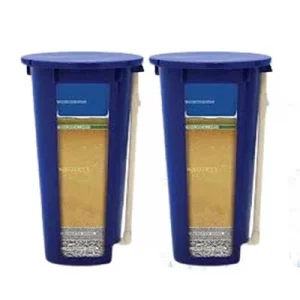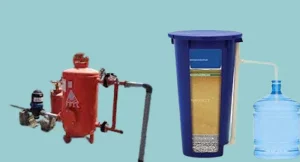If you don’t know what size sand filter for above ground pool this article helps you to determine the size of sand filter for above ground pool. Sand filters are used to remove dirt from the water in swimming pools. They consist of several layers of sand, which act as a filter. A fine mesh cover is placed over the top layer of sand. It allows the sand to act as a filter and prevents leaves and other debris from entering your pool. In many cases, sand filters have a backwash function. This means that after a certain amount of time has passed, they will automatically clean themselves.
In this article, we will discuss what size sand filter is best for above ground pool.
What is a Sand Filter?
Sand filters are designed to prevent leaves and other debris from entering your swimming pool. In order to be effective, they must be properly maintained. They also require periodic cleaning. If they aren’t cleaned regularly, they may clog and cause problems with your pool water. The best way to keep your sand filter working is to periodically clean it. This can be done manually or automatically. There are automatic sand cleaners available for sale at most swimming pool supply stores. Some people prefer to use homemade methods for cleaning their sand filters.
A sand filter is a pool filter that uses special sand as a natural filtering agent. This sand contains many holes and spaces that allow water to pass through the filter without being caught.
Some people prefer sand filters because of their simplicity. They are also easy to install, and since they are not powered by electricity or gas, you can move the unit around your pool freely. You don’t need to drain the pool first to change the filter, and you won’t have to worry about getting it wet during cleaning.
A sand filter can work for both salt and fresh water pools.
How Sand Filters Work
 Sand filters are very similar to other types of filter systems.
Sand filters are very similar to other types of filter systems.
However, they require regular cleaning to remove the captured debris from the sand. This can be done regularly or every month, depending on the needs of your household. A common misconception about these filters is that they are not self-cleaning.
If you want to find out how sand filters work, keep reading this article. We will explain everything you need to know about them and include some helpful tips that will ensure you get the most from your filter.
The sand filter uses gravity to move the water in a circular motion and catch the debris on the surface of the sand particles. This process is very similar to how a spa filter works.
The difference is that the sand filter doesn’t use chemicals or air. Instead, it relies on the naturally occurring minerals in the sand to trap the debris.
What size sand filter should I get?
Choosing the right sand filter is important because it directly affects your pool’s performance. A standard pool filter will need to be cleaned every six months and replaced every 3 years. If your pool is above ground and you use a booster pump, you can use a larger filter. This would be more suitable for a pool with an average water volume of around 400-600 gallons.
When it comes to choosing a sand filter size, one needs to be cognizant of the following points:
- The maximum size of a pool that will fit the sand filter
- The available space within the pool
- The pool depth
Pool depth is of paramount importance because the filter needs to be placed near the bottom of the pool, preferably just below the surface, to work effectively and get rid of any debris that may have made its way into the pool. The best way to find out how deep your pool is is by looking at the liner; if the liner is thick enough, it should be no more than 4 inches deep.
How to Determine Your Sand Filter Size?
- For a 20,000-gallon capacity, a 12″ or 18″ sand filtered system has a 1.5″ sq. ft filtered area.
- For an above-ground pool with a 25,000-gallon capacity, you’ll need a 16″ or 20″ sand filtered system.
- A 1.75″ sq. ft. mesh filter can be used with a 10,000- gallon pool because the filter has an 18″ x8″ sq. ft. area, which is large enough to provide adequate filtration.
- If you have a smaller pool, a 5,000-gallon pool or less, then a 6″ sand filter would be an ideal choice for you.
- However, if you choose a 16″ sand filtered system for a 10,000- gallon pool, you will have only 5,000 gallons to work with. In other words, you will need to have a smaller filter to have enough room for the water to flow through the sand. The first thing to look at when buying a pool filter is the amount of surface area being filtered by the unit.
What size sand filter for above ground pool?

Selecting the right sand filter for your pool can be difficult if you’re not sure how they work or differ from each other. Fortunately, this guide will help you with that and make it easier to find the best sand filter for your pool. If you’re looking for more information, here are some of the things to know about sand filters:
1. Measure the pool size
First, you will need to measure the width and length of your pool. You can do this by measuring the dimensions from the center line (the bottom edge) of the collection to where it begins to curve inward. In other words, the pool is flat until it curves inward, so if you measure it at that point, you will get the distance between the pool’s center and its inside edge. Once you have determined that distance, divide the pool length by the space and multiply it by the number of feet to get the width.
When measuring the pool size, you want to be sure to measure from the inside of the wall. This will help you determine the correct size of the filter.
2. Calculate gallons
Determine how many gallons of water are in the pool. Multiply this amount by 8 and divide it by 4,000 to get the number of gallons of pool water per day. This is the total volume of pool water you will have to filter.
Using the following formula, you can calculate how many gallons will be screened in 8 hours.
Gallons per hour = (Pool size in gallons) / (8 hours per day)
In most cases, this should be approximately 100 gallons.
Add up the total square footage and divide that number by the gallons of water that you will be filtering. For example, if you have a 10×10 foot pool that you will be screening, you would add up the square footage (100 square feet) and multiply that by the number of gallons you plan to filter (1000 gallons). You would then divide the total by the gallons of water in 8 hours (1000 gallons). In this case, you would divide 100 (square feet) by 1000 (gallons of water in 8 hours). The answer would be 10.
3. Determine the sand filter flow rate
The first thing you should do when you are looking to purchase a sand filter is to determine the flow rate of the sand that you need. The flow rate is determined by how many gallons of water are filtered per hour. This means that the larger the flow rate, the smaller the sand filter.
The maximum flow rate of your pool pump is calculated in gallons per minute. Multiply the horsepower of your pool pump by 12. In this example, the horsepower of your pump is 500, and you would multiply that by 12 (500 x 12 = 6000). Then divide the result by the gallons per minute your pump can produce (6000/60 = 10 GPM).
The maximum flow rate is the amount of water the filter can process in an hour. The maximum flow rate depends on the size of the pool.
You must also check the flow rate of your sand filter. This is the amount of water the sand filter can remove from your water system. The larger the flow rate, the more water you can remove.
4. Check Your Sand Filter’s Capacity
You must check the Capacity of your sand filter. You can measure the amount of water passing through the filter. If you measure the amount of water that passes through your filter, you can determine how big your filter should be. If you have a small filter, you may not get enough water. You may be wasting money on excess filtering if you have a large filter.
5. Calculate the Number of Grains of Sand
You must also calculate the number of grains of sand that you need. You can do this by multiplying the Capacity of your sand filter by the flow rate. You can then multiply the result by the number of gallons of water in your home. The product of these three numbers is the number of grains of sand that you need.
Next, you will need to calculate the Capacity of the sand filter. You will do this by multiplying the tank’s cubic feet by the filter’s height. For example, a 50-foot-long sand filter would have a 100 cubic foot capacity.
6. Choose your filter system
The filter system you choose will depend on the square footage of your pool and the flow rate you have calculated. The higher the flow rate, the more influential the filter system. The flow rate is measured in gallons per minute. The higher the flow rate, the more influential the filter system.
There are several different filter systems available. They range from simple gravity systems to robust filtration systems.
7. Install the filter & accessories
Most filter systems require the installation of the filter itself. In addition, you will need to purchase accessories such as the sand filter bag and filter media.
Conclusion:
It is important that you check the size of your sand filter and make sure that it is large enough to accommodate the water volume that you have. Some filters can hold up to 10 gallons of water. This will ensure that the water stays clear and clean. If you are going to buy a new sand filter, be sure to get the one that is compatible with your pool. A standard pool will usually have a sand filter with a diameter of 4 feet. A typical above ground pool may have a diameter of 12-18 inches. If you have a small pool, it will probably have a smaller diameter. It is important that the sand filter has a capacity of at least 3 cubic feet.